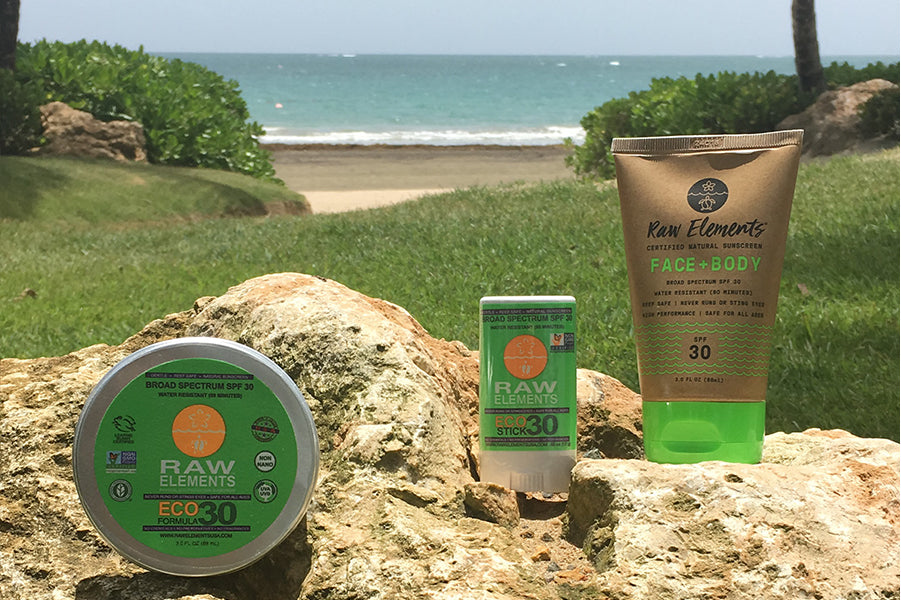
Safer Sunscreens For You & The Environment
Taken from Raw Elements Website
UNDERSTANDING UV RAYS
It is important to understand how UV radiation affects our skin. First and foremost, sunlight is a source of life energy for all living organisms. As humans, we need a healthy amount of sun daily to ensure we acquire adequate Vitamin D, which is necessary for cellular function. Overexposure to UV radiation is where issues arise and needs to be avoided.
There are two types of ultraviolet rays; UVA and UVB. UVA is comprised of UVA1 & UVA2. UVA rays, the “tanning” rays, are deeper penetrating and responsible for longer term skin aging, wrinkles and cellular damage. Overexposure to UVA rays is now believed to be a key contributor toward the most aggressive and potentially deadly form of skin cancer, Melanoma. UVB rays are primarily responsible for reddening or “burning” of the outer layers of skin. UVB damage and sunburn can also cause skin cancer. Each incidence of burning to a peel is believed to increase one’s risk of skin cancer by 50%. To easily remember the difference between the two: UVA (aging/tan) and UVB (burning/sunburn). Overexposure to both UVA and UVB rays is carcinogenic and can cause skin cancer.
Some additional facts about UV rays:
- The intensity of UVA rays remains constant throughout the seasons of the year.
- UV exposure can be increased by as much as 25%, 50% and 80% from the reflection off of sand, water and snow respectively.
- UVA rays penetrate through glass windows all year round
- Higher Elevations increase the intensity of UV rays and can possibly lead to exposure of UVC radiation.
- Over 90% of UV radiation hitting the earth are UVA rays.
- Over 80% of UV radiation, especially UVA radiation can penetrate cloud cover all year round.
- UV damage is cumulative throughout our lifetime. Meaning, each occurrence piles on top of the previous. Each time a person sunburns to a peel, their risk of cancer increases by 50%. Persons with more than 40 moles are 3 times more likely to develop skin cancer.
SPF EXPLAINED
SPF (Sun Protection Factor) refers to the amount of protection against UVB rays a sunscreen offers. This amount is measured in percentages and is not a linear scale. For instance:
- SPF 15 blocks 93% of UVB rays
- SPF 30 blocks 97% of UVB rays
- SPF 50 blocks 98% of UVB rays
Therefore, SPF 50 only provides 1% more protection than SPF 30.
All sunscreen, whether SPF 15 or 70 needs to be applied and reapplied properly. An SPF of 30 does not mean that a sunscreen protects your skin for 2xs longer than SPF 15. It does not measure a product’s ability to protect your skin from UVA rays, which are also damaging.
Most dermatologists recommend a broad spectrum sunscreen with SPF 15 or SPF 30 for a few reasons. First, sunscreens with very high SPFs do not offer much more protection than SPF 30 and give people a false sense of security that they are more protected than they actually are. Also, in order to have true broad spectrum protection, the UVA protection should be at least 1/3 of the UVB protection. Sunscreens with high SPFs typically have much greater UVB protection than UVA. Lastly, typically, double or triple the amount of chemicals are needed to achieve an SPF higher than 30.
BROAD SPECTRUM PROTECTION
Sunscreen’s most important job is to provide true broad spectrum protection. Broad Spectrum protection refers to a product’s ability to effectively mitigate the harmful effects of both UVA and UVB rays. Under the FDA regulations, a product marked ‘Broad Spectrum’ will now be mandated to filter a balanced amount of UVA relative to its SPF (UVB) claim. Zinc Oxide is the only active ingredient that solely provides protection against both UVA and UVB rays, which is why it is in the only active ingredient in our sunscreens.
CHOOSING THE RIGHT SUNSCREEN
With label claims, ingredient lists and testing translations being so confusing, it is important for consumers to understand how to go about choosing sunscreens that are safe and effective.
- Choose Broad Spectrum Non-Nano Zinc Oxide protection. There are 18 FDA approved active ingredients in sunscreen. While many of these offer UVB protection, only four offer any UVA protection. Many sunscreens use a combination of these to provide both UVA and UVB protection. Zinc Oxide is the only broad spectrum active, which means it is the only single ingredient that physically blocks the entire range of UVA and UVB rays. Look for Non-Nano Zinc Oxide percentages to be over 18% and the only active ingredient.
- Use SPF 30. It is a widely accepted that Broad Spectrum SPF 30 is the benchmark needed to provide adequate UVB & balanced UVA protection.
- Look for “Water Resistant 80 Minutes”. The term “Water Resistant 80 Minutes” is regulated by the FDA. It represents a sunscreenʼs ability to remain effective after 80 minutes of exposure to water. “Waterproof” and “All Day Protection” claims are misleading and against FDA regulations. A product that is “Water Resistant 80 Minutes” will likely offer better sweat resistance as well.
- Avoid Sprays and Powders. Avoid sprays or powder sunscreens at all costs. These types of applications expel excess amounts of chemical ingredients which are inhaled and pose a health hazard. Additionally, these chemicals go airborne and indiscriminately pollute the environment. Furthermore, it is nearly impossible to determine the amount being applied and quite often skin coverage is not effective.
USING SUNSCREEN EFFECTIVELY
Equally as crucial to choosing the right sunscreen, and maybe even more challenging, is how to go about using this sunscreen properly. The manner and amount of sunscreen a consumer applies will dramatically affect sunscreen performance.
- Sunscreen is the last line of defense, not the first. It is imperative that a complete approach toward sun protection is used. Contrary to popular belief, no sunscreen alone will keep you totally protected. It is always suggested to stay out of peak sun between the hours of 10am and 2pm, seek shade and wear protective clothing and hats. Avoid extended periods of exposure, never allow skin to sunburn and avoid a deep tan, as both UVA and UVB rays cause skin cancer.
- Apply more than enough. To ensure sunscreen is as effective as advertised, the correct amount must be applied. The FDA regulates that all sunscreens must be SPF tested in the amount of 2mg of formula per square centimeter of skin. What this means is that an adult wearing only shorts must use one full ounce of sunscreen per application to cover all the exposed skin properly. Approximately a teaspoon size amount is needed to adequately protect the face, ears and neck. Using less than the correct amount drastically reduces the sunscreens ability to protect the skin and the SPF claim will not be met. The average consumer applies 25% of the necessary amount of sunscreen per application, making an SPF 30 turn into about an SPF of 5. An easy way to apply is to put on enough to leave an even, visible film over the desired coverage area, then rub in to the desired look.
- Apply early, reapply often. The vast majority of chemical sunscreens require early application, at least 30 minutes prior to sun exposure to be effective. Reducing this time period will reduce the effectiveness of the sunscreen. However, Non-Nano Zinc Oxide is effective the moment it is evenly applied to the skin. It is imperative to reapply sunscreen often, at least every eighty minutes during long periods of sun exposure. Regardless how “Water Resistant” a formula is, it is wise to reapply after any water exposure, sweating or towel drying.
SUN PROTECTION TIPS
Although our sunscreens are a great first line of defense, we want to offer you some sun safety tips to get optimal protection:
- Always wear UV protective clothing, including hats, sunglasses, rash guards, etc.
- Limit your time in the sun between the hours of 10am and 2pm, when the sun is most intense.
- Always stay hydrated and seek shade whenever available.
- Young children need even more protection from heat and sun.
OUR CORALS ARE DYING
- 40% in Hawaii
- 40% in the Great Barrier Reef
- 85% in the Caribbean
- 99% in the Florida Keys
INGREDIENTS BANNED IN ECO-MARINE RESERVES:
|
|
|
|
|
|
|
|
|
|
|
|
|
|
|
|
|
|
|
|
|
|
|
|
|
|
